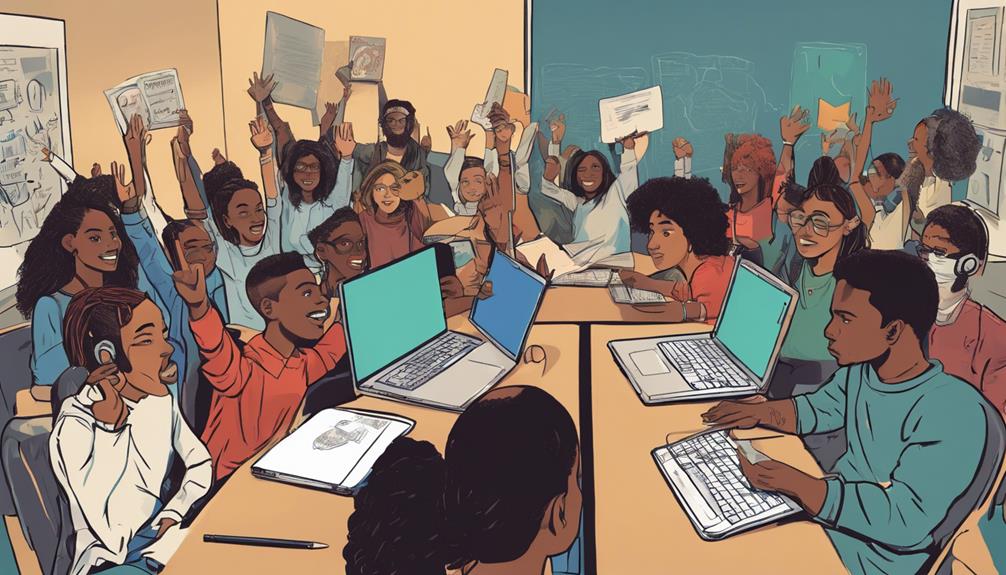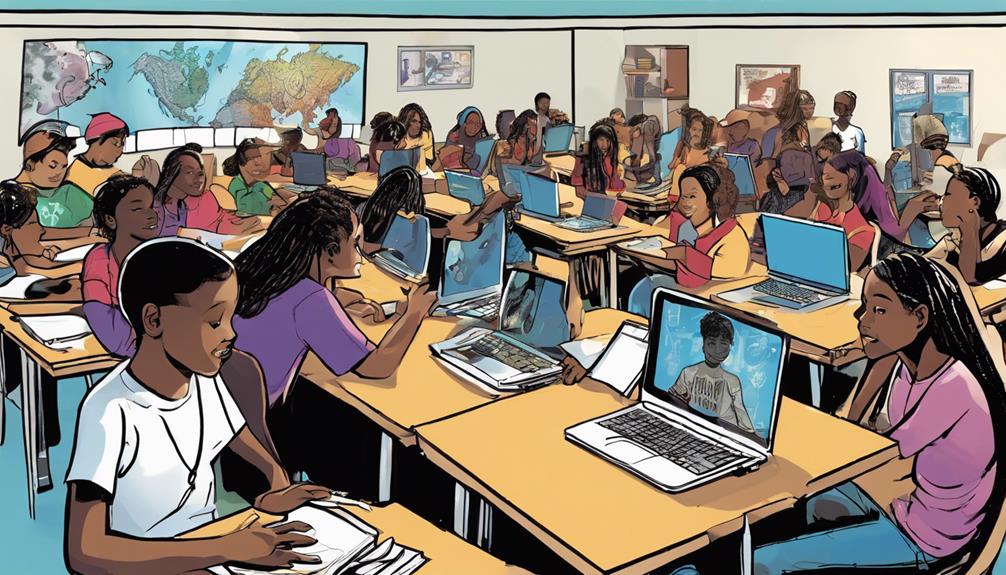Managing a hybrid classroom means using **essential tech tools**, planning fun lessons, building connections, keeping students interested, and making good use of time. Use the right hardware, ensure everyone has a device, and help remote students with video tools. Plan lessons that mix both in-person and remote topics, and aim to make them fun. Create a sense of community to bridge the gap, encourage interaction, and use real-world applications to keep students engaged. Use time wisely by prioritizing activities and setting clear timelines. **Master** these strategies for hybrid classroom success. [Learn more about maximizing your hybrid classroom potential.](#)
Key Takeaways
- Integrate essential technology tools for seamless hybrid classroom operation.
- Meticulously plan engaging lessons for both in-person and remote learners.
- Foster a sense of community by encouraging interaction and participation.
- Boost student engagement with interactive activities and multimedia resources.
- Manage time effectively by prioritizing tasks and establishing clear timelines.
Technology Integration Essentials
Incorporating essential technology tools and devices is vital for seamless integration in the hybrid classroom setting.
To facilitate effective online classes, teachers and students must have appropriate hardware like cameras, screens, projectors, and microphones. Universal use of similar devices fosters collaboration and guarantees a smooth learning experience.
Remote students may require guidance on utilizing video conferencing tools to engage actively in lessons. It is essential to maintain traditional classroom management principles even in the virtual environment.
Mastering Lesson Planning

Efficient lesson planning is fundamental for successful navigation of the hybrid classroom environment. To master lesson planning effectively, teachers should consider the following:
- Organize: Meticulously plan and organize lessons to guarantee smooth delivery.
- Prioritize: Determine key topics for in-person and remote learning, balancing both environments.
- Engage: Create engaging activities that foster participation and interaction among all students.
Fostering Community Engagement

To cultivate a thriving learning environment in a hybrid setting, fostering community engagement is essential. Building a sense of community helps bridge the physical gap between in-person and remote learners. Encouraging interaction and participation beyond the curriculum is vital. Teachers play a pivotal role in modeling ideal conduct to enhance student engagement.
By implementing engagement tactics, such as promoting closeness, boosting morale, and ensuring psychological safety, students are more likely to actively participate in the learning process. Creating opportunities for both in-person and remote students to collaborate and engage with one another can greatly enhance the overall learning experience.
Boosting Student Engagement

Enhancing student engagement is pivotal in creating a dynamic and interactive learning environment within the hybrid classroom setting. To boost student engagement effectively, consider the following strategies:
- Implement interactive activities to stimulate interest and participation.
- Utilize multimedia resources to cater to diverse learning preferences.
- Provide real-world applications of concepts to enhance relevance and motivation.
These approaches can help students feel more connected to the material and foster a sense of active involvement in their learning process.
Efficient Time Management

Managing time effectively in a hybrid classroom requires meticulous planning and coordination to optimize student learning experiences. Efficient time management guarantees the smooth flow of lessons and activities, maximizing the benefits of both in-person and remote learning. To assist in this endeavor, consider the following strategies:
| Time Management Strategies | Description | Benefits |
|---|---|---|
| Prioritize Tasks | Organize tasks by importance | Enhances productivity |
| Set Clear Deadlines | Establish clear timelines | Promotes accountability |
| Utilize Technology Tools | Use tools like calendars | Facilitates organization |
| Create Daily Schedules | Plan daily activities | Improves time allocation |
| Review and Adjust | Regularly assess progress | Allows for timely changes |
Frequently Asked Questions
How Can Teachers Ensure Equal Participation Between In-Person and Remote Students?
Teachers can promote equal participation between in-person and remote students by fostering an inclusive environment through balanced engagement strategies, involving all students in discussions, interactive activities, and collaborative tasks. Regularly monitoring and encouraging participation are key.
What Are Some Effective Strategies for Managing Student Distractions in a Hybrid Classroom?
In a hybrid classroom, managing student distractions is essential for maintaining focus. Implement strategies like setting clear expectations, utilizing interactive tools, fostering student accountability, and providing structured breaks to enhance engagement and minimize disruptions.
How Can Teachers Encourage Peer-To-Peer Interaction in a Hybrid Setting?
To foster peer-to-peer interaction in a hybrid setting, teachers should facilitate collaborative activities, group discussions, and teamwork tasks that engage both in-person and remote students. Encouraging communication through various platforms can enhance social connections and learning outcomes.
What Tools Can Be Used to Track Student Progress and Engagement in Real-Time?
In the dynamic landscape of hybrid education, utilizing tools like interactive dashboards, real-time polling software, and AI-driven analytics can enable educators to monitor student progress and engagement with unparalleled precision, fostering a conducive learning environment.
How Should Teachers Handle Technical Issues During Live Hybrid Classes?
During live hybrid classes, teachers should promptly address technical issues by calmly troubleshooting or seeking immediate technical support to minimize disruptions. Clear communication, preparation with backup plans, and familiarity with technology are key to maintaining the flow of instruction.
Conclusion
To sum up, successfully managing the hybrid classroom requires strategic planning and effective implementation of technology tools, lesson plans, community engagement, student involvement, and time management.
One interesting statistic to note is that according to a recent survey, 76% of teachers believe that integrating technology in the classroom has improved student learning outcomes.
By following these essential tips and strategies, educators can create a cohesive learning environment that meets the needs of both in-person and remote students.










